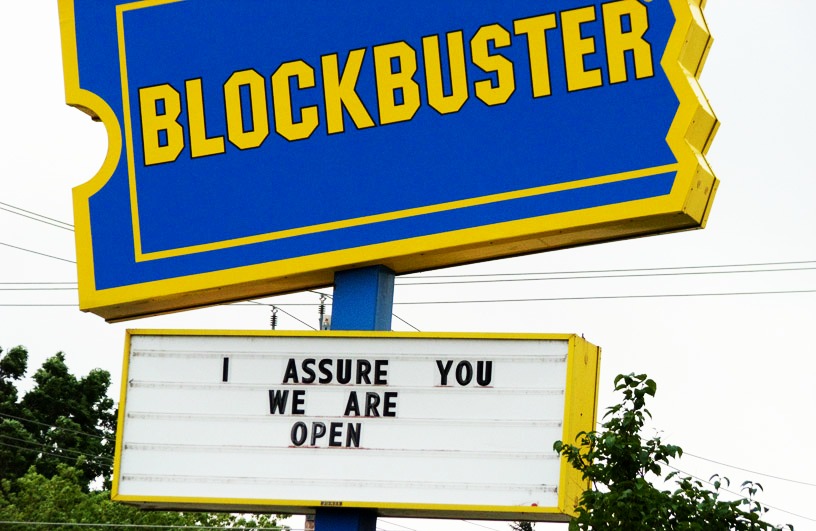“I’ve been frankly confused by this fascination that everybody has with Netflix […] Netflix doesn’t really have or do anything that we can’t or don’t already do ourselves.”
-Blockbuster CEO Jim Keyes, in a 2008 interview with CBS News
In the mid-2000s, Blockbuster Video was the world leader in movie rentals. The famous blue and yellow stores had spread across the globe, operating in over 9,000 locations and generating an annual revenue of $5.9 billion USD. They were stocked with thousands of DVDs and knowledgeable employees who often provided their own film recommendations. By 2010, Blockbuster was bankrupt and all of its brick and mortar stores empty, essentially gutted by the Netflix-led tsunami of online movie rental and digital streaming.
What makes your DMO’s visitor centre relevant today?
In the last decade, technology has disrupted all aspects of tourism marketing, including visitor servicing. In the past, consumers relied on DMO information sources including guidebooks and visitor centres, often going directly to a building to gain physical materials and insight from a destination’s staff. But in 2017, travellers can access an infinite amount of destination information online and make bookings in their own home or on the go without ever having to step into a counter-and-brochure-rack centre. Around the world, visitor numbers are dropping in visitor centres, while travellers expectations have shifted. This brings into question the relevance and ROI of these centres.
While travellers might like the idea of a visitor centre, they don’t necessarily depend on them anymore and tend to bypass them unless there is a specific need. This is just like Blockbuster vs. Netflix. If they can get what they need online, they’re not going to spend their time going to a building. So what is a DMO to do?
Many DMOs have found success in moving away from passively waiting for visitors to walk through their centre’s doors seeking brochures and information. These DMOs have instead focused on providing travellers with the things they need the most (which isn’t always information), at places the travellers already are. Some visitor centres have transitioned into traveller lounges with coffee and free Wifi in order to attract more visitors. Other centres, often in cities, employ technology, turning it into a “selfserve” model and reducing staff costs. Several DMOs are taking visitor servicing on the road by making visitor centres portable or implementing volunteer ambassador programs in order to “go where the visitors are”.
Some DMOs are adding elements of a visitor centre or moving their visitor centre to an existing tourism attraction to be closer to in-market travellers. Others, like Nashville Convention & Visitors Corp., have turned their visitor centre into a tourism experience unto itself by hosting musicians that help travellers experience the city’s famous live music.
Which type of visitor centre is right for your destination?
Every situation is different and in many cases, the traditional visitor centre makes sense. The “killer app” for visitor servicing is the human touch. In a technology-driven economy, there is still value in talking to knowledgeable, unbiased individuals. This explains the power of word of mouth.
DMOs need to identify the places in the customer journey where talking to a visitor counselor is worth the investment because it either removes a key roadblock, or it adds a lot of value to the destination experience.
Here are some questions that can help you make this assessment:
- What are the key roadblocks, challenges and opportunities in the customer journey for your target audience (from awareness to visitation)?
- What roadblocks or challenges are best addressed through the human touch of visitor servicing?
- How does your current visitor servicing model align with these?
Based on the outcome of the questions above, every DMO can make the assessment if the investment needed in visitor servicing is worth it in the context of other organizational (and political) priorities.
Don’t let your visitor centre turn into the next empty Blockbuster video store. The modern traveller is changing fast, but DMOs can lead the way.
Destination Think has helped many destinations create a visitor servicing strategy that is better suited to the needs of today’s travellers. Contact our strategic consultancy today to find out how we can assist your DMO.
Featured image credit: Better Than Bacon, Flickr










Great article John!
We’re currently running a ‘Visitor Servicing + Destination Marketing Bootcamp’ to help DMOs and VICs adjust their visitor servicing to suit the change in consumer behaviour that you’ve highlighted in your article.
We specifically look at online servicing and storytelling tactics that organisations can implement to engage visitors along their whole purchase journey, without having them need to come into a traditional bricks and mortar VIC.
Hopefully this will help the organisatiins participating remain a relevant and important part of their local visitor economies ?